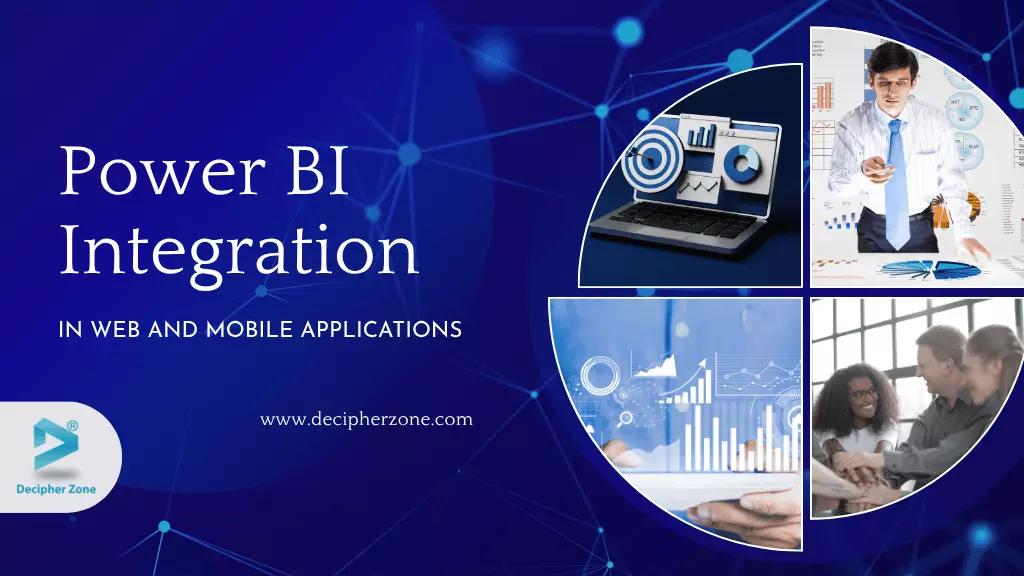Let your data be more than interactive and insightful with Power BI. You can get your hands on a full guide to Power BI integration for the complete information as this blog explores from advantages to practical applications, embedding options, challenges tools and techniques, security and cost. Let’s get started!
Imagine having your business insights available at your fingertips, right inside your web or mobile app. That’s exactly what Power BI allows you to do. Microsoft’s flagship analytics tool, Power BI, is transforming how developers and organizations consume data by offering seamless embedding options directly into the applications we use every day.
Let’s break down everything you need to know to get started with embedding Power BI like a pro.
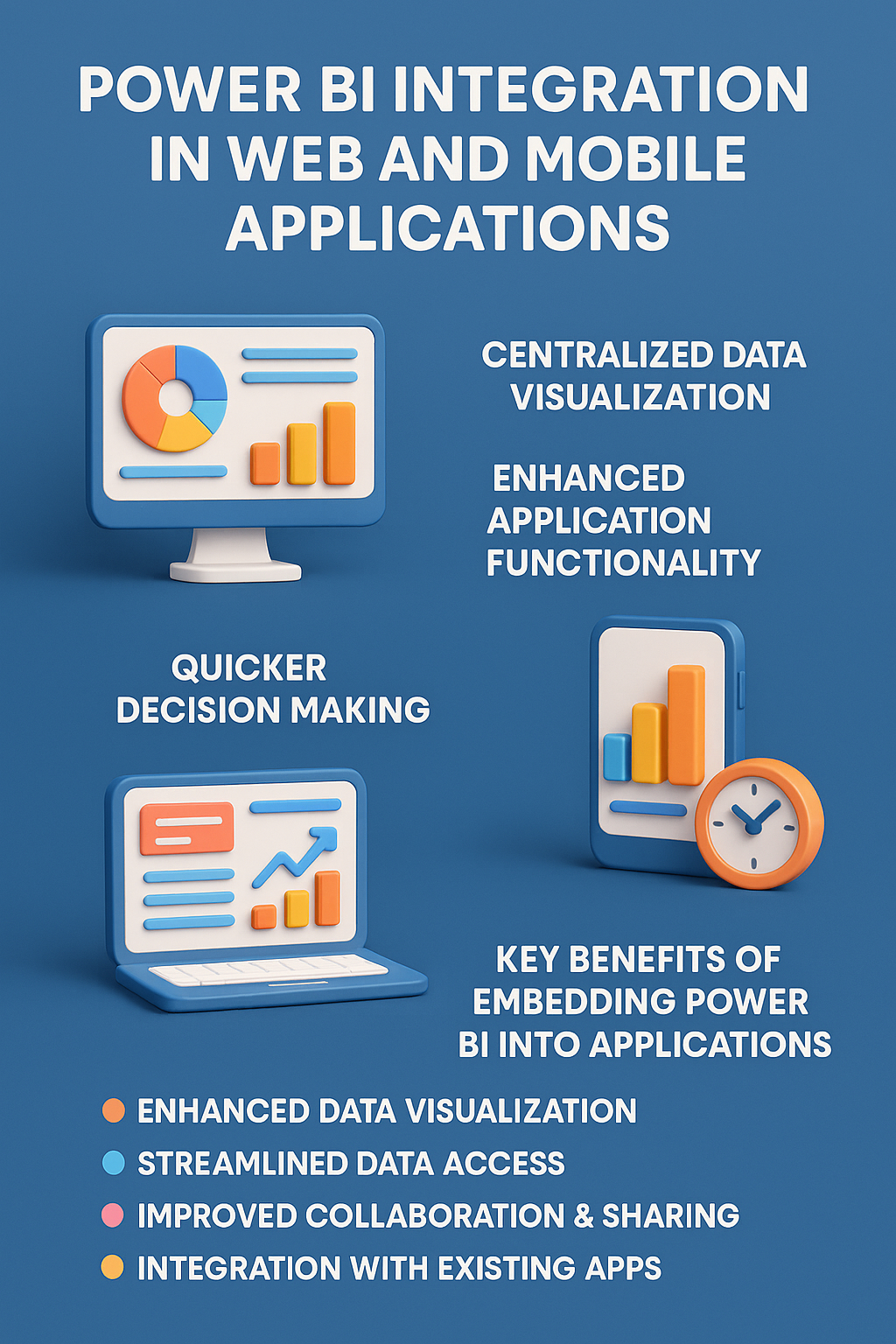
Basics to Power BI
Power BI is a business intelligence tool developed by Microsoft that allows you to visualize data in actionable reports and interactive dashboards, connect to various data sources and share them with others. This leading platform helps businesses integrate seamlessly with other Microsoft tools. It consists of three main components:
-
Power BI Desktop: This is a free application to install on the computer to connect, transform and visualize data. It can connect to various data sources, combine them and create data models.
-
Power BI Service: This is an online publishing service that allows users to publish your reports and dashboards created in Power BI Desktop and share them with others.
-
Power BI Mobile Apps: These can allow users to view reports and dashboards on the go integrated in applications, providing access to data insights anywhere.
Read: Guide to Develop AI-Based Retail Web Analytics Software
Why Integrate Power BI into Web and Mobile Applications?
There are countless reasons why businesses are investing in Power BI integration with their apps:
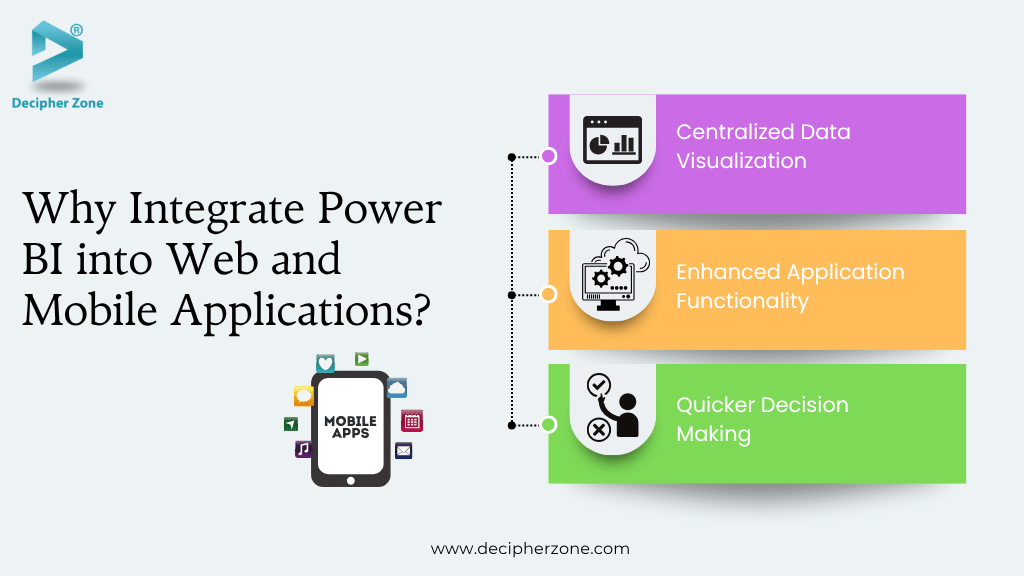
-
Centralized Data Visualization: Consolidating data from various sources into a single platform to allow users to no longer jump to present and visual using dashboards and reports. This enhances understanding and decision-making, providing a unified view of data.
-
Enhanced Application Functionality: By adding analytical capabilities to existing systems like CRMs and ERPs. This integration transforms raw data and provides more value to users with better understanding of business processes and decision making tools.
-
Quicker Decision Making: It enables businesses an easy access to create dashboard and reports that refresh automatically to reflect the most updating data without manual intervention. This allows users to track metrics, monitor performance and make informed decisions based on real time insights.
Key Benefits of Embedding Power BI into Applications
Embedded Power BI into applications offer several advantages for easier collaboration and sharing insights, reduce the need for Power BI Pro licenses and enables monetization of insights through data access fees.
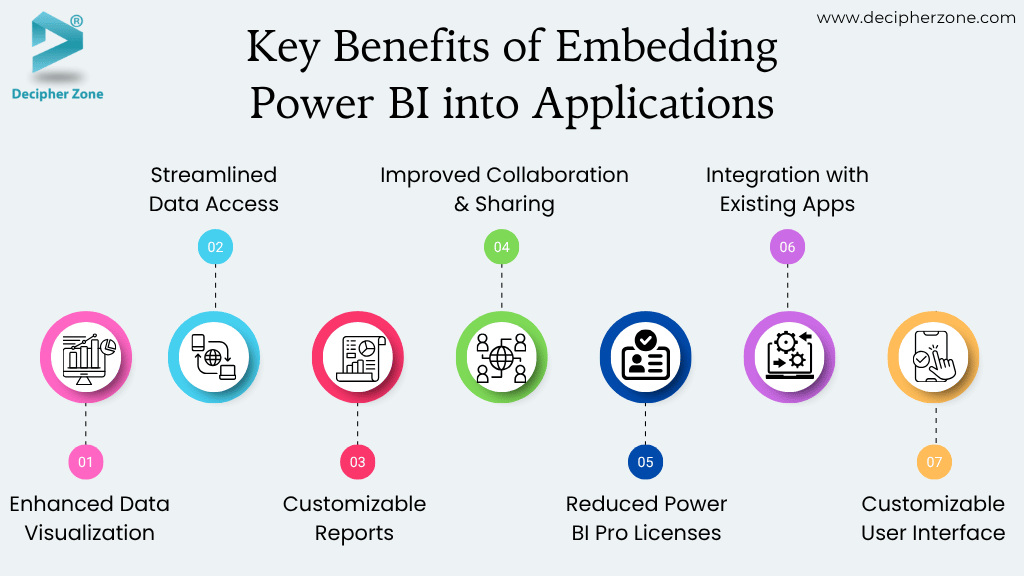
Here is the list:
-
Enhanced Data Visualization: Offers interactive and customizable dashboards and reports that can be embedded directly into the applications.
-
Streamlined Data Access: Users can eliminate the need to switch between multiple tools and provide real-time data insights into the existing application.
-
Customizable Reports: Provide reports and dashboards to the specific needs and ensure the data is presented in a relevant and useful manner for the user.
-
Improved Collaboration & Sharing: Facilitates easy sharing of data insights with internal and external users for better decision making and cross functional collaboration.
-
Reduced Power BI Pro Licenses: Businesses can charge users for access to embedded Power BI reports and dashboards, generating additional sources of income.
-
Integration with Existing Apps: Integrating seamlessly with existing apps to leverage data visualization within the workflow.
-
Customizable User Interface: Businesses can customize their user interface to match application’s branding and user experience.
Common Use Cases for Power BI Integration
Power BI, a cloud-based data visualization and business intelligence service is commonly used across various industries for diverse apps. Below is a table illustrating the industries that primarily utilize Power BI:
| Industries | Uses |
|---|---|
| Healthcare | Analyze patient data, monitor hospital operations and performance metrics, and track drug inventory all in one place. |
| Retail | Customer behavior analysis, monitor real-time sales, inventory levels, and manage inventory with visual dashboards. |
| Manufacturing | Analyze productivity in the production line, supply chain, and demand forecasting. |
| Fintech | Financial reporting, visualize budgeting, forecast trends, manage risks, detect fraud, and track financial KPIs across departments. |
| Education | Analyze student performance, institutional KPIs, funding metrics, and course effectiveness. |
Embedding Options: What Are Your Choices?

Power BI Embedded vs. Publish to Web
-
Power BI Embedded: Meant for developers and ISVs; integrates dashboards into custom apps with full control and user authentication.
-
Publish to Web: Public sharing of reports, not secure or suitable for sensitive data.
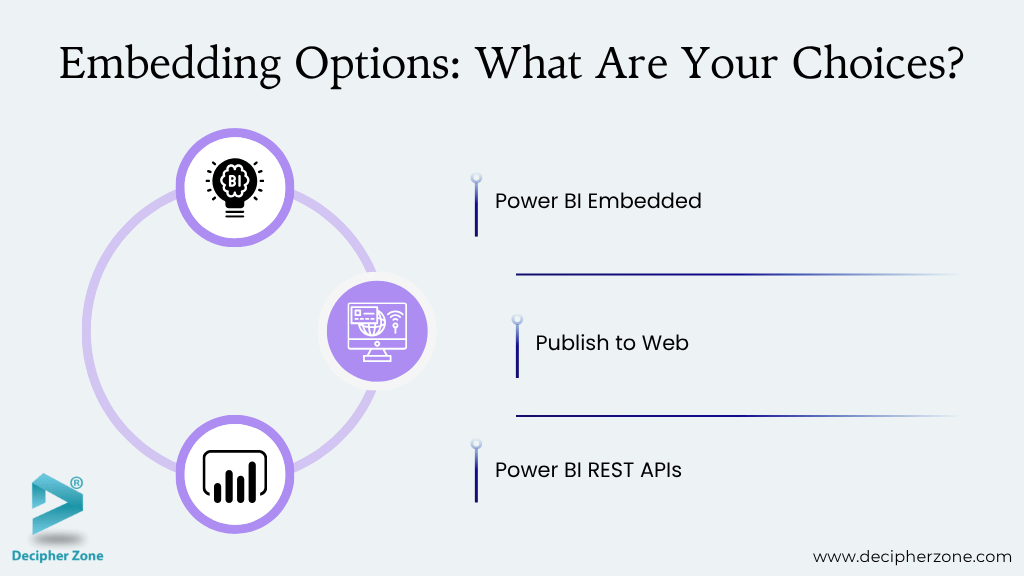
Power BI REST APIs
The Power BI REST API allows developers to create, manage, and interact with datasets and dashboards programmatically. It’s the backbone for any serious integration and supports tasks like:
-
Embedding content
-
Refreshing datasets
-
Managing workspaces
Requirements Before You Begin
While integrating Power BI, ensuring data format is suitable for analysis and team members have basic technical skills or access to training. Below is the detailed discussion:

Licensing:
-
Power BI Pro: Suitable for smaller teams with internal requirements that offer collaboration features.
-
Power BI Premium: Required for large scale embedding and external users that provides dedicated capacity for scalability.
Authentication:
-
Azure AD: Used for verifying user identity that ensures access control.
-
Service Principal: Ideal for app-only scenarios where authentication is needed without user interaction.
-
Master Account: Authenticates the application on the behalf of the user that simplifies the user experience.
Read: Web Application Development Process
Tools and Technologies You’ll Need for Power BI Integration in Web and Mobile Applications
Power BI needs several tools and technologies to integrate, allowing users to create and publish reports. Here are some tools and technologies listed in details:

-
Power BI Service: A cloud-based platform to create, publish and share your report and dashboards.
-
Azure Active Directory (Azure AD): Cloud-based identity and access management service used for authentication and authorization when integrating Power BI. This ensures secure access to your data.
-
Power BI Embedded: Allows to embed Power BI content into existing systems which enables users to access reports and dashboards directly from the platforms. It offers the hosting and licensing infrastructure for these embedded reports.
-
JavaScript SDK: Offers a library of functions to programmatically embed Power BI content into your web apps.
-
REST API: A set of programming interfaces, allowing to interact with the Power BI service such as managing reports, datasets and other resources, essential for backend integration.
-
Visual Studio/ Code Editor: Development environment for not only building but modifying the apps to interact with and embed Power BI content.
Security Considerations and Best Practices for Power BI Integration
It is crucial to prioritize security to safeguard sensitive information and ensure compliance with regulations when integrating Power BI. By following these practices, businesses can create a robust security framework within Power BI.
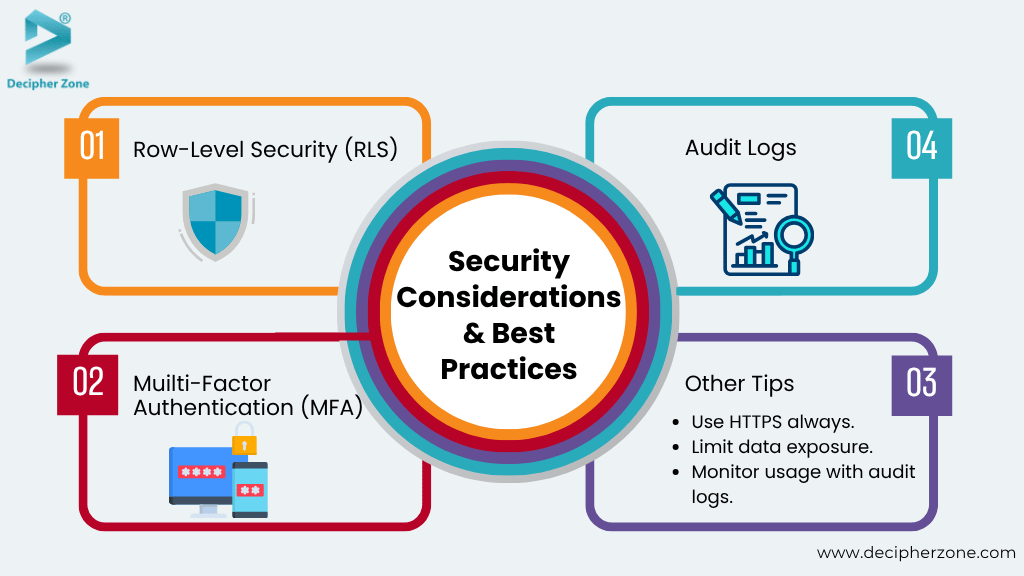
There are several best practices should be considered, here are some examples:
-
Row-Level Security (RLS): Restricts user access to specific data that ensures that users only see the information relevant to them. This is a crucial security feature for preventing data breaches and maintaining data privacy.
-
Muilti-Factor Authentication (MFA): Adds an extra layer of security by allowing users to provide multiple verification factors. This makes it harder for unauthorized users to gain access.
-
Audit Logs: Track user activities that offer valuable information into potential security breaches or unauthorized access. Regularly reviewing these logs can help identify and address potential security vulnerabilities.
Other Tips
-
Use HTTPS always.
-
Limit data exposure.
-
Monitor usage with audit logs.
Performance Optimization Techniques of Embedded Power BI Reports
Performance optimization of Power Bi report prioritize import mode whenever possible for faster loading. Minimize visual load and optimize data refresh strategies when using DigitalQuery.
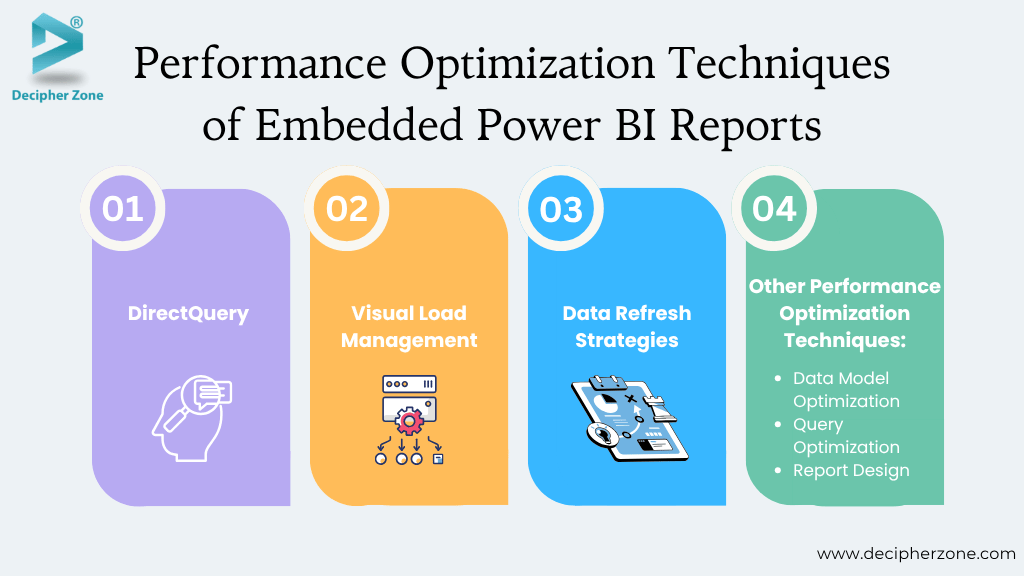
-
Using DirectQuery Efficiently: DirectQuery can be slower due to the need to process queries as it allows querying data directly from the source in real-time. It is best used when the source data changes frequently and import mode is not suitable.
-
Visual Load Management: visual load management ensures that visuals are displaying the most relevant and filtered data. This reduces the number of visuals on a page and minimizes processing as each visual adds to the load time.
-
Data Refresh Strategies: incremental refresh technique focuses on updating only the data that has changed which decreases the time required for complete refresh. By leveraging this technique, businesses can enhance efficiency and streamline their data management processes.
-
Other Performance Optimization Techniques:
-
Data Model Optimization: This technique improves the performance using star schema, optimize relationships, reduce data size and DAX measures instead of calculated columns.
-
Query Optimization: Applying restrictive filters early and to minimize data processing.
-
Report Design: Leverage Power Query for data transformation and optimize reports with drilldowns and hierarchies by creating a proper date table for time intelligence.
-
Read: Trends in Mobile App Development for 2025
Common Challenges of Power BI
There are several challenges businesses face however it can be managed with solutions like optimizing data models, using aggregations, implementing incremental refresh and employing best practices for data integration and DAX expressions.
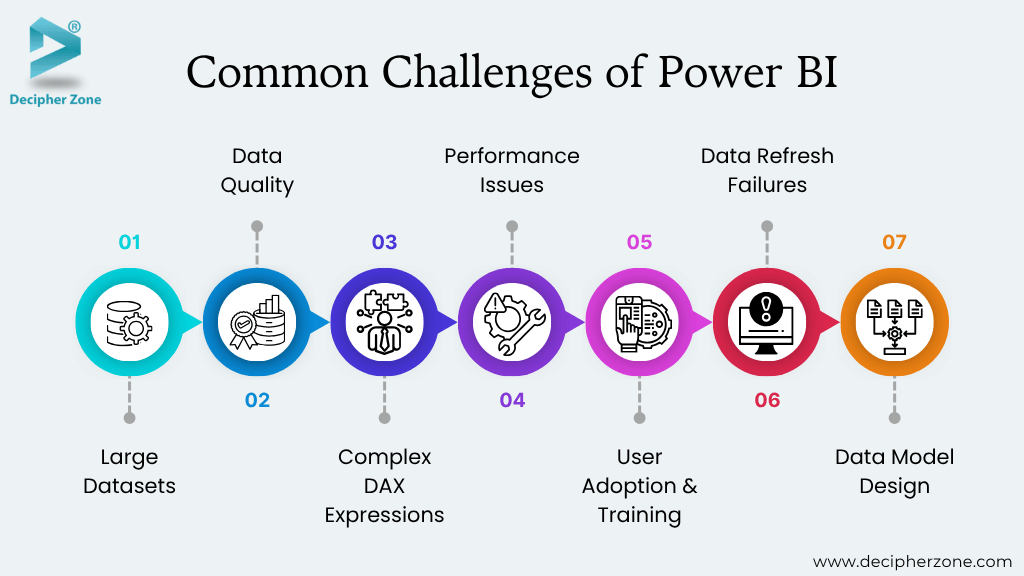
Here are the challenges to overcome and be prepared for future circumstances:
-
Large Datasets: Power BI may experience slow refresh and performance issues with large datasets.
-
Data Quality: Data which is inaccurate, inconsistent or incomplete can provide unreliable insights and inaccurate reports.
-
Complex DAX Expressions: Writing and fixing complex DAX expressions is time-consuming and error prone.
-
Performance Issues:With large datasets or complex visualizations, reports can become slow and unresponsive.
-
User Adoption & Training: To understand Power BI’s features and functionalities and how to create effective reports, some users may struggle and can impact adoption.
-
Data Refresh Failures: Due to various reasons including network issues or data sources connectivity issues scheduled data refreshes can fail.
-
Data Model Design: Data designed inappropriately can impact performance and lead to inaccurate results.
With these challenges come the areas of improvement. These requires solutions like simplifying DAX expressions and use calculated columns, implement data cleansing and transformation processes, use Power BI’s data connectors and dataflow to integrate data from multiple sources, provide comprehensive training and support to help users become proficient in using Power BI, implement data governance policies, appropriate security measures, monitor data refreshes, check data source credentials and review error messages to troubleshoot problems.
Cost of Power BI Integration in Web and Mobile Applications
Power BI offers a few pricing plans tailored to different business goals and budgets.
Here is a more comprehensive breakdown:
|
Version |
Price |
|
Power BI Free |
Free– enables users to create and view reports locally. Restricts the sharing option or collaboration. |
|
Power BI Pro |
Costs $14 per user per month— enabling to share and collaborate reports and publish content to workspace. |
|
Power BI Premium (Per User) |
Costs $24 per user per month—offering all features of Power BI Pro with advanced AI, higher refresh rates and larger model size. |
|
Power BI Premium (Capacity) |
Capacity-based license—allowing you to pay for a dedicated unit of capacity. (Suitable for larger organizations) |
|
Power BI Embedded |
For embedding analytics into custom applications and is licensed by capacity or per user. |
Our Approach to Power BI Integration
Our approach to Power BI integration is by understanding your business needs, leveraging POwer BI’s capabilities and creating tailored solutions. This involves a few steps such as planning, data preparation, designing and ongoing support, requiring strategic alignment with your goals, deep customization and secure data management.

With years of experience in custom software development, Decipher Zone helps you leverage the benefits of Power BI by embedding rich, interactive dashboards and reports directly into their apps. Our team ensures seamless integration using best practices, robust APIs and secure architecture tailored to your infrastructure—on-premise, cloud-based or hybrid.
At DZ, our experts can design and implement Power BI solutions that are scalable, insightful and budget-friendly. We ensure a smooth workflow from consultation to deployment and ongoing support. Turn your data into interactive visualizations and powerful business insights. Contact us for a free consultation!

FAQs
What is Power BI Embedded?
Power BI Embedded is a service that allows developers to integrate Power BI reports, dashboards and tiles into apps with full control and security. This provides users interactive data visualizations and analytics. With Power BI developers can create rich, data-based experiences for their users.
Is it safe to embed Power BI in apps?
Yes, if you use Power BI Embedded with authentication via Azure AD and proper token management. Mainly for internal portals or websites but security is crucial to consider and choose the right embedding method depending on the existing system. You can avoid using the Publish to web option if your data is confidential or proprietary, and if your data source is on-premise, a data gateway can be used to bridge the gap between the online Power BI service and your secure network.
Can Power BI be embedded in mobile apps?
Absolutely, You can use SDKs for native apps or WebView for cross-platform solutions. Power BI provides dedicated mobile apps for iOS and Android that allows users to view and interact with Power BI reports and dashboards without needing to access the Power BI portal. Power BI Embedded is designed for ISVs and developers who require embed power BI content within their applications.
Do I need Power BI Premium for embedded reports?
Not always, Power BI Pro works for internal use, but Premium or PPU is required for external or high-scale use. Depending on the scenarios like in embedding for your organization where user owns data requires Premium Per User (PPU) licenses or a Premium capacity (P or EM SKU) that allows users to access the embedded reports without needing Pro licenses themselves. While in embedding for your customers where the app owns data. The owner is responsible for the data and requires a Premium capacity to support the embedded reports.
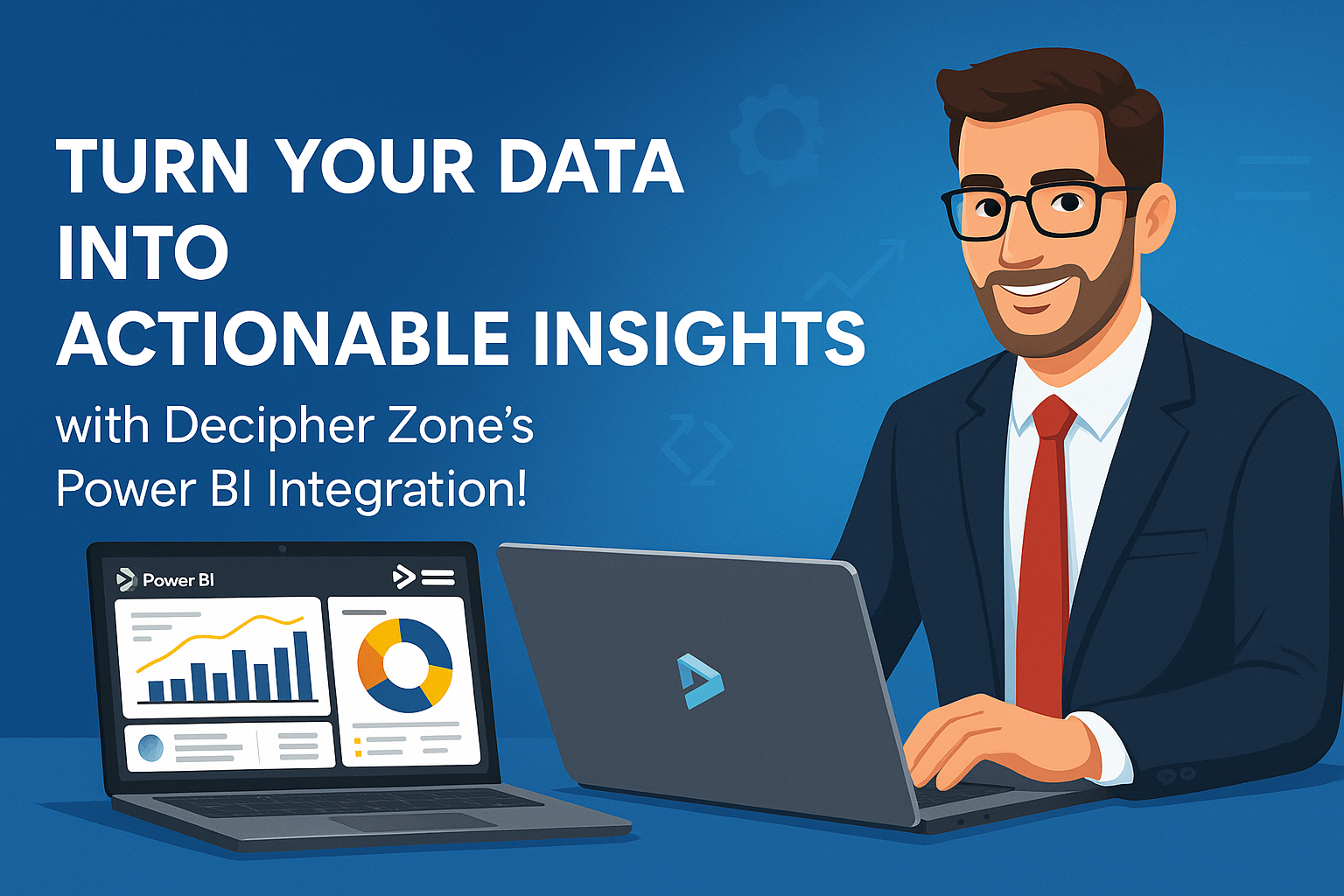
**Disclaimer: Some images used in this article have been generated with the assistance of AI.

